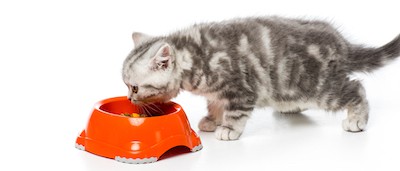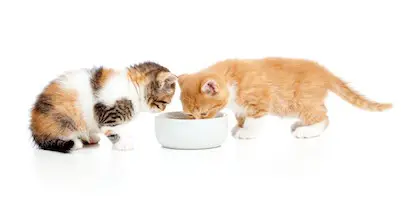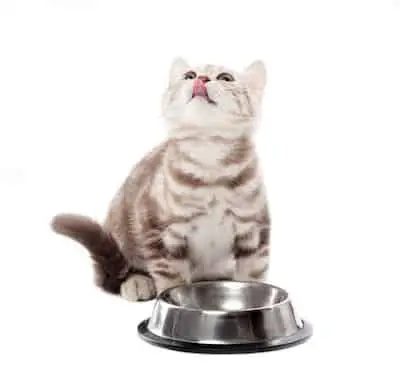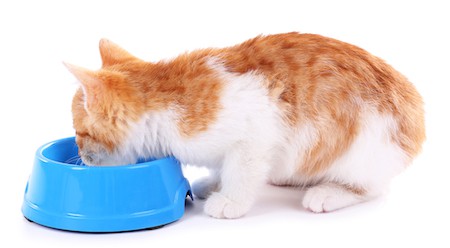Updated on
Most kitten lovers have experienced this scenario: having the need to visit a local pet store only to find out it is already closed. Now, how would you feed your little four-legged friends?
Contents
- 1 What is Kitten Supplement Formula?
- 2 Why Would Kittens Need Emergency Kitten Formula?
- 3 What Should the Content of Your Kitten Formula Recipes Include?
- 4 Kitten Formula Recipes: How to Make Kitten Formula with Evaporated Milk?
- 5 Homemade Kitten Formula without Yogurt
- 6 The Feeding Process
- 7 How Many Feedings Needed Per Day?
- 8 Bring your kitten to a vet if he has any of the following symptoms:
- 9 What Not to Feed?
Kittens are very subtle species, born with an average weight of 85 to 113 grams. They need special and nutritional needs, which are usually provided by the milk of a mother cat. This is crucial in the first 24 to 48 hours.
But if the mother is not available, you can find a substitute for kitten milk formula. Make sure this formula is nutrient-rich. A loving hand and regular, frequent feeding are important to provide them with the needed nurturing, which is essential for their emotional, psychological, and physical development and growth.
What is Kitten Supplement Formula?


Also called Kitty Glop, the kitten supplement formula is an easy to eat food filled with nutrition. This is specifically suited to orphaned kittens, cats recovering from an ailment, older cats that essentially need dietary supplementation, cats with gum or dental problems, as well as nursing mother cats and their babies.
Canned kitten foods and other commercial kitten formulas are available, but homemade formulas are easy and healthy. Not to mention, it is inexpensive
Why Would Kittens Need Emergency Kitten Formula?
Newly born kittens are usually helpless and tiny. Though, this is not a real issue since they are fed and cared for by their mother. But in most cases, challenges take place that doesn't allow kittens to have access to the milk of their mother, like:
- The mother is suffering from illness.
- The mother had abandoned her brood or has been killed.
- The brood may be very big for the mother cat to handle.
- The mother is suffering from illness.
This is where kitten formula is highly helpful and beneficial. A fatten cat is what you want to see, so give them a specific nutrition that contains the right balance of nutrients and proteins for a happier and healthier growth.
What Should the Content of Your Kitten Formula Recipes Include?
Your chosen pet stored based kitten milk replacer should contain meat-based protein, taurine, vitamins, and minerals. 'What if I don't have access to these milk replacers?' Not a big problem, really!
You can try these household items:
- Condensed milk (must contain minerals, vitamins, and amino acids)
- Sulphur acid or taurine can be replaced with full-fat plain yogurt or fish oil
- Salad oil (salmon, olive, soybean)
- Egg yolk that is rich in vitamins, minerals, and protein
Kitten Formula Recipes: How to Make Kitten Formula with Evaporated Milk?
It is advised not to give kittens a cow's milk, but you can use evaporated milk as your best alternative.
Things you will need:
- Mixing bowl
- Saucepan
- List Element
- Hand mixer
- Small nursing bottle
Recipe 1
Ingredients:
1 can evaporated milk
1 large egg
1 tsp. of nutritional yeast
2 tsp of powdered protein
Steps:
- Beat the egg and mix in the remaining ingredients.
- Put the formula in a small nursing bottle and place it in a bowl or cup of hot water. Let warm.
- Check the temperature by testing the formula on the base of your wrist. If it is still too hot, wait until it turns cold. But if the formula is too cold, just continue soaking the small bottle in hot water.
- Test again the formula before giving to the kitten.


Recipe 2
Ingredients:
10 oz. evaporated milk
1 raw egg yolk
1 cup whole fat yogurt
2 tbsps. of regular mayonnaise
3 oz. sterilized water (boiled water or baby water)
Steps:
- Put all the ingredients in a blender.
- Mix until blended well.
- Let it warm to kitten body temperature before feeding
- The formula is ready to give to your kitten.
You can use this formula for seven days. But, it is not a good idea to reuse the formula that you've warmed. Dispose it off and use a new formula for every feed. You may have to make the hole quite bigger when using the bottles.
Recipe 3
Ingredients:
1 can evaporated milk (regular size)
1/2 tsp. honey
1 equal size water
8 oz. container plain yogurt
1 strained jar baby food meat (e.g. veal, lamb, or chicken)
Steps:
- Mix all the ingredients.
- Refrigerate up to three days and heat in the microwave.
This kitten formula may specifically be a good supplement for nursing large litters.
If you don't have a small nursing bottle, you can make use of an eye dropper (make sure it is thoroughly clean). Slowly drip small drops of milk formula in the mouth of your kitten. You can use a small spoon or syringe without a needle, too, if none is available.
Homemade Kitten Formula without Yogurt


If you don't have access to yogurt or the store is already closed, there are many homemade kitten formula recipes without yogurt you can try.
Recipe 1
Ingredients:
10-12 oz. of Pedialyte
12 oz. can of goat's milk
1 tsp. of Karo syrup
2 tbsps. of mayonnaise
1 package Knox gelatin
2 jars of baby meat
Steps:
- Boil the Pedialyte and then add the gelatin. Dissolve.
- Add other ingredients. Blend well until mixed.
- The mayonnaise will elevate to the top and will clump, so this will be lump-filled.
This recipe makes lots of formula, so you can freeze it inside a pint container. Defroze it in the microwave and use for two or three feedings. Discard the leftover.
Recipe 2
Found an orphaned baby bunny? This recipe could be of utmost help!
Ingredients:
1 egg yolk
1 cup whole milk
A few drops of liquid baby vitamins
1 tsp. sulfured molasses (do not use honey)
Steps:
- Stir all the ingredients.
- When feeding, use a Q-tip. Add extra formula to the Q-tip using an eyedropper.
The Q-tip distribute the milk in a kind of seeping pattern like the doe's nipple usually would.
The Feeding Process


Knowing how to feed the kitten properly is an important part of the process. So, here's how to feed your lovable pet.
- Make sure the formula is mixed well. There should be no lumps.
- On a soft surface, put the kitten on its tummy at a forty-five angle. Tilt the bottle and let it nurse.
- If the kitten is not sucking well, open his mouth carefully and fit the nipple in.
- After each feeding, let him burp. Do this by holding the kitten to your chest with his head raised. Using your fingertips, tap his back.
How Many Feedings Needed Per Day?
Depending on the kitten, he will eat less often or more often. He sleeps quietly if he is contented, but he may be hungry or cold if he cries.
- Birth-1 week: 3 hours/8 feedings a day
- 1-3 weeks: 4 hours/6 feedings a day
- 3-4 weeks: 5 hours/5 feedings a day
- 4-5 weeks: 4 to 5 feedings a day
Bring your kitten to a vet if he has any of the following symptoms:
- Diarrhea or vomiting
- Rejection to eat within twelve hours
- A runny nose or eyes and sneezing
- Severe flea infestation
What Not to Feed?
It is okay to give kittens treats, providing you strictly follow the ten percent calorie rule. Meaning to say, the treats must only make not more than ten percent of the amount of calorie consumption of your kitten. Take necessary precautions to these foods as well:
- Raw eggs as it consists of salmonella and can reduce the Vitamin B absorption. This eventually results in hair and skin coat problems.
- Milk as it causes diarrhea especially in weaned litters. Mainly because they lost the enzyme essentially required for breaking down milk.
- Raw fish as it leads to Vitamin B deficiency. As a result, your kitten may deal with seizures, loss of appetite, or worse, death.
- Raw liver or meat as it consists of harmful bacteria and parasites.
Aside from these mentioned foods, you should not feed kittens with foods that contain raisins, grapes, chocolate, garlic, onions, and even tea and coffee.
After around 7 weeks, introduce your kitten to nutritious solid kitten food. Try a combination of dry food and wet food to ensure they will be getting the calories that their body needs.